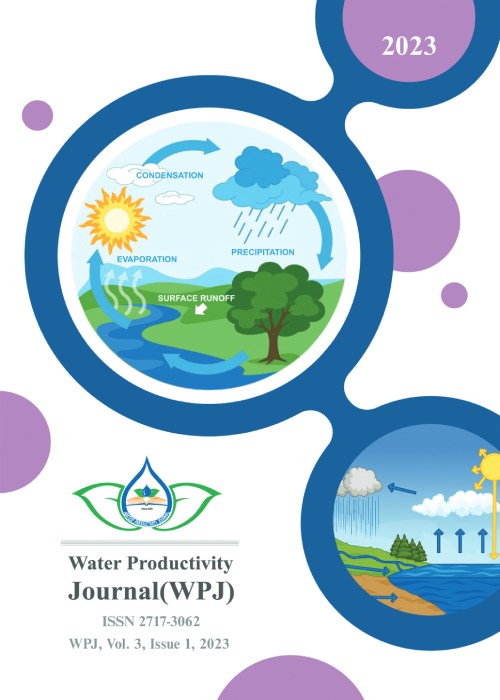Validation of Manning’s n equations for a swale with a subdrainage channel as water storage
Author(s):
Article Type:
Research/Original Article (بدون رتبه معتبر)
Abstract:
Introduction
Stormwater management is the effort to reduce runoff of rainwater ormelted snow into streets, lawns and other sites and the improvement ofwater quality, according to the United States Environmental Protection Agency (EPA). When stormwater is absorbed into the soil, it is filtered andultimately replenishes aquifers or flows into streams and rivers. However, when heavy rainwater hits, ground saturated by water createsexcess moisture that runs across the surface and into storm sewers androad ditches. Thiswater often carries debris, chemicals, bacteria, eroded soil, and other pollutants, and carries them into streams, rivers, lakes, or wetlands. In urban and developed areas, impervious surfaces such as pavement androofs prevent precipitation from naturally soaking into the ground. Instead, water runs rapidly into storm drains, sewer systems anddrainage ditches and can cause flooding, erosion, turbidity (ormuddiness), storm and sanitary sewer system overflow, andinfrastructure damage. However, stormwater design and “greeninfrastructure” capture and reuse stormwater to maintain or restorenatural hydrologies. Detaining stormwater and removing pollutants is the primary purpose ofstormwater management. Pervious Surfaces that are porous and allowrainfall and snowmelt to soak into the soil, Gray infrastructure, suchas culverts, gutters, storm sewers, conventional piped drainage, andBlue/Green infrastructure that protect, restore, or mimic the naturalwater cycle, all play a part in stormwater management.In stormwater management systems, a swale is one of the flow control-at-source facilities. The application of swale with a subdrainage channel in Malaysia urban areas is new and promising to control urban flash floods. Rainfall-runoff infiltrate to the subdrainage can be stored and become proper irrigation sources and increase the benefits of water productivity due to maximize the income and profits either in agricultural yield or as non-portable water supply.Material and methods
The Manning Equation is the most commonly used equation to analyze open channel flows. It is a semi-empirical equation for simulating water flows in channels and culverts where the water is open to the atmosphere, i.e. not flowing under pressure, and was first presented in 1889 by Robert Manning. The channel can be any shape - circular, rectangular, triangular, etc. The units in the Manning equation appear to be inconsistent. The Manning Equation was developed for uniform steady state flow. For uniform steady flows, the energy gradeline = the slope of the water surface = the slope of the bottom of the channel. Manning n varies with the roughness of the pipe, culvert, or channel. The higher the n, the rougher the material. This study was done in REDAC’s Hydraulic Laboratory, Engineering Campus, Universiti Sains Malaysia, and the data have been used to validate the suggested Manning equations. By using flow meter and measuring tape, velocity and flow depth of each case (GFO, GPO2 and GPO4) with different slopes at M2, M3 and M4 were recorded. The measurements of the velocity and flow depth have been taken three times at each location. Data recorded have been use as input to calculate flow. All data were analysed by using Microsoft Excel 2013.Results
Observed flow rates gained in this study, were used to validate Manning’s (n) equation that developed through the previous study that recommended to be used in designing subdrainage channel. The performance of flow capacity in a single module of the swale subdrainage channel is also discussed. An experimental setup was carried out in a six-meter flume by using the River Engineering and Urban Drainage Research Centre (REDAC) module as a subdrainage channel or ecological subsurface module. These physical model test runs were conducted to evaluate the efficiency of hydraulic capacity due to backwater or blockage effects at the end of the channel. Three gate scenarios were applied to represent the blockage. Manning roughness coefficient influenced inversely proportionate by flow capacity with maximum value is 0.020. It shown in the subdrainage module, the main parameter that controls the flow attenuation is module roughness itself.Conclusion
Flash flood issues in the urban area become tremendously crucial and flow attenuation is believed may tackle the issue. By slowing down the flow to the downstream area, a high infiltration rate would have occurred and implementation of a subdrainage channel with a single module that is located underneath the swales can accelerate the infiltration process consequently slow down the upstream flow to reach the downstream area. It is concluded that the developed equation for Manning’s prediction has been validated through a good and significant agreement between predicted and observed results with an R2 value of 0.77.Keywords:
Language:
English
Published:
Water Productivity Journal, Volume:2 Issue: 2, Spring 2022
Pages:
61 to 72
magiran.com/p2484629
دانلود و مطالعه متن این مقاله با یکی از روشهای زیر امکان پذیر است:
اشتراک شخصی
با عضویت و پرداخت آنلاین حق اشتراک یکساله به مبلغ 1,390,000ريال میتوانید 70 عنوان مطلب دانلود کنید!
اشتراک سازمانی
به کتابخانه دانشگاه یا محل کار خود پیشنهاد کنید تا اشتراک سازمانی این پایگاه را برای دسترسی نامحدود همه کاربران به متن مطالب تهیه نمایند!
توجه!
- حق عضویت دریافتی صرف حمایت از نشریات عضو و نگهداری، تکمیل و توسعه مگیران میشود.
- پرداخت حق اشتراک و دانلود مقالات اجازه بازنشر آن در سایر رسانههای چاپی و دیجیتال را به کاربر نمیدهد.
دسترسی سراسری کاربران دانشگاه پیام نور!
اعضای هیئت علمی و دانشجویان دانشگاه پیام نور در سراسر کشور، در صورت ثبت نام با ایمیل دانشگاهی، تا پایان فروردین ماه 1403 به مقالات سایت دسترسی خواهند داشت!
In order to view content subscription is required
Personal subscription
Subscribe magiran.com for 70 € euros via PayPal and download 70 articles during a year.
Organization subscription
Please contact us to subscribe your university or library for unlimited access!


